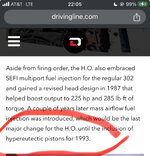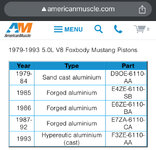Bingo! Don't want to rattle those slugs, they shatter.
You are using an out of date browser. It may not display this or other websites correctly.
You should upgrade or use an alternative browser.
You should upgrade or use an alternative browser.
Hypereutectic Pistons & High Zinc Oils
- Thread starter garageman402
- Start date
No, the S55 uses Mahle 174+ (AlSi12Cu4Ni2Mg), not 2618. It is grafal coated though.As previously noted, eutecticity is a property of the alloy and eutectic alloys melt and solidify at single lower temperatures than any of their individual constituents. This is very helpful in certain applications like soldering; you get a better joint.
BMW S55 and later M engines use Mahle 2618 pistons with Grafal or other Mahle coatings and specify a full SAPS oil in the US. I have never heard of any coating issue with the ZDDP content in normal FS Euro oils.
source (bmw): http://s3.bimmerfile.com.s3.amazonaws.com/wp-content/uploads/2015/01/S55-Engine.pdf
Last edited:
Yup, Ford migrated the 302HO from TRW forged slugs to hypereutectic ones in like 91 or 92? I can't remember the exact date, but the idea was to tighten up piston-to-wall clearance, reduce blowby and positively impact emissions performance. These engines were more fragile than their predecessors when you added boost.
The roller motors in general were weaker. If you didn't crack a stock hyper piston, you were cracking the block, snapping an oil pump shaft, or chewing up a distributor gear.
The TRW pistons were pretty durable but stupid heavy. I know a lot of people who wanted to use them in a new build and get a shock when they see cost of balancing.
Last edited:
Nitrous tuneups on hypereutectic pistons are always on the “fat” side with retarded ignition timing to soften the shockwave when the combustion pressure spikes. I’ve run as high as 175 shot on a stock ‘95 5.0 Ford short block with no issues proving that hypereutectics can live like this, so it can be done, but you always have to creep up on the tune. If you go for the gusto without verifying spark, fuel, and nitrous levels things will be disastrous very quickly!
If you keep it safe like this, IMO the limiting factor is only when the piston top and top ring gets so hot that the ring gap closes completely; imagine popping dandelion heads off, but with hot aluminum and disastrous results
My dad and I, back when I was in high school, abused the snot out of a stock '86 302 until it blew. We had a 408W ready to go in so we decided to spray the stock 302 and see how much it would take. We started with a 63 jet, then went to I think a 78, then a 93, (somewhere in there) and then a 110 jet (~380 hp shot) which was the biggest we had. We went a step richer than needed on the fuel side, running it at ~11:1 AFR, and locked the timing at 20° or 22°, something like that. It survived 6 1/4-mile passes like that before the #2 piston turned to shrapnel right after the nitrous hit on the 7th pass. It made a nice window in the block and the oil pan had dents from the inside outward from chunks of the piston flying down into it. Two other pistons were broken at the ringlands. The funny part, it wasn't even a structural limitation issue. The fuel solenoid failed.
MolaKule
Staff member
I had a "college" Vega and the only reason they didn't last was the sheet metal body which became a rust bucket in short time. Not even the police wanted to stop me; too embarrassing.The Chevrolet Vega used a hypereutectic aluminum block and high zinc oil. I don’t think any of them survived past the 80s.
Last edited:
91 was the last year of the forged pistons in the 5.0HO.Yup, Ford migrated the 302HO from TRW forged slugs to hypereutectic ones in like 91 or 92? I can't remember the exact date, but the idea was to tighten up piston-to-wall clearance, reduce blowby and positively impact emissions performance. These engines were more fragile than their predecessors when you added boost.
I should clarify it was the model year 91.
Ah yes, it was the aftermarket Motorsport kit that uses the 2618. My bad.No, the S55 uses Mahle 174+ (AlSi12Cu4Ni2Mg), not 2618. It is grafal coated though.
source (bmw): http://s3.bimmerfile.com.s3.amazonaws.com/wp-content/uploads/2015/01/S55-Engine.pdf
Incorrect, the 87-late 92 built H.O. engines had TRW forged pistons. ‘93-95 MY had hypereutectic.91 was the last year of the forged pistons in the 5.0HO.
I should clarify it was the model year 91.
Attachments
92 was the year of the changeover. Late '92 model years that had the black oil pans (like the '93's) had the cast pistons. Early '92's with the grey oil pan had forged pistons. I used 91 as the last full year of forged piston production.Incorrect, the 87-late 92 built H.O. engines had TRW forged pistons. ‘93-95 MY had hypereutectic.
OVERKILL
$100 Site Donor 2021
Yeah, couldn't remember if it was 91 or 92.91 was the last year of the forged pistons in the 5.0HO.
I should clarify it was the model year 91.
EDIT, mentioned the crossover, but see you already covered that, lol.
- Joined
- Mar 19, 2022
- Messages
- 671
Did you name the car " Tetness"?I had a "college" Vega and the only reason they didn't last was the sheet metal body which became a rust bucket in short time. Not even the police wanted to stop me.
I once had a friend tell me the secret to keeping his Vega alive was to "Change 1 plug every month." I did an oil change on it once for him.I had a "college" Vega and the only reason they didn't last was the sheet metal body which became a rust bucket in short time. Not even the police wanted to stop me.
By the time the Vega engine went into production the engine problems had nothing to do with the block alloy. GM’s process for honing and etching the bores was a mature process and that was the best thing about that engine. It had other design flaws that caused it to overheat and that was what killed public perception of the model. Even those were subsequently corrected but by then it was too late and sales were doomed.
A lot of people think the problem was the all-aluminum block but it was not.
A lot of people think the problem was the all-aluminum block but it was not.
Do you know what motor that is from? Those top rings are waaay down the piston
Similar threads
- Replies
- 80
- Views
- 3K
- Replies
- 14
- Views
- 1K
- Locked
- Replies
- 71
- Views
- 13K
- Replies
- 2
- Views
- 849



